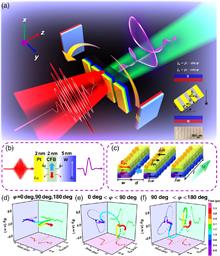Search by keywords or author
News and Commentaries
Advanced Photonics
- Mar. 25, 2025
- Vol. 7, Issue 2 (2025)
Research Articles
Qing Yang, Yan Huang, Houyi Cheng, Reza Rouzegar... and Tianxiao Nie|Show fewer author(s)
Advanced Photonics
- Mar. 21, 2025
- Vol. 7, Issue 2 (2025)
Research Articles
Exploring uncharted multiband hyperbolic dispersion in conjugated polymers: a first-principles study
Suim Lim, Dong Hee Park, Bin Chan Joo, Yeon Ui Lee, and Kanghoon Yim
Advanced Photonics
- Mar. 14, 2025
- Vol. 7, Issue 3 (2025)
Research Articles
Hong Liang, Wai Chun Wong, Tailin An, and Jensen Li
Advanced Photonics
- Mar. 12, 2025
- Vol. 7, Issue 2 (2025)
Research Articles
Zhong Wen, Qilin Deng, Quanzhi Li, Yizhou Tan... and Qing Yang|Show fewer author(s)
Advanced Photonics
- Mar. 10, 2025
- Vol. 7, Issue 2 (2025)
AP Highlights
Terahertz (THz) waves are located between microwaves and infrared light in the electromagnetic spectrum. They can pass through many materials without causing damage, making them useful for security scanning, medical imaging, and high-speed wireless communication. Unlike visible light or radio waves,...
Advanced Photonics
- Mar. 25, 2025
- Vol. 7, Issue 2 (2025)
AP Highlights
Distributed acoustic sensing (DAS) systems represent cutting-edge technology in infrastructure monitoring, capable of detecting minute vibrations along fiber optic cables spanning tens of kilometers. These systems have proven invaluable for applications ranging from earthquake detection and oil exploration to railway monitoring and submarine cable surveillance. However, the massive amounts of data generated by these systems create a significant bottleneck in...
Advanced Photonics
- Mar. 25, 2025
- Vol. 7, Issue 2 (2025)
News
Quantum computing has the potential to revolutionize information processing by leveraging the principles of superposition, entanglement, and quantum interference. Photonic quantum computing, in particular, is emerging as a promising platform due to its intrinsic scalability, robustness to decoherence, and ability to operate at room temperature. Recent advances in integrated photonic circuits, quantum light sources, quantum memory, and quantum error correction are rapidly shaping the future of th
Advanced Photonics
- Mar. 18, 2025
- Vol. , Issue (2025)
AP Highlights
Miniaturized spectroscopy systems that can detect trace concentrations at the parts-per-billion (ppb) level are of utmost importance in applications ranging from environmental monitoring and industrial process control to biomedical diagnostics. However, the existing bench-top spectroscopy systems are too large, complex, and impractical for narrow-space use. Furthermore, the traditional laser spectroscopy techniques use bulky components like light sources, mirrors, detectors, and gas cells to det
Advanced Photonics
- Jan. 07, 2025
- Vol. 6, Issue 6 (2025)
Top Downloads
- Advanced Photonics
- Vol. 6, Issue 6, 060501 (2024)
- Advanced Photonics
- Vol. 6, Issue 5, 050500 (2024)
- Advanced Photonics
- Vol. 6, Issue 6, 066001 (2024)
- Advanced Photonics
- Vol. 6, Issue 3, 036003 (2024)
- Advanced Photonics
- Vol. 6, Issue 3, 035001 (2024)
- Advanced Photonics
- Vol. 6, Issue 6, 060502 (2024)
Article Video

Coherence entropy during propagation through complex media
Advanced Photonics
- Jul. 18, 2024
- Vol. 6 Issue 4 046002 (2024)
















